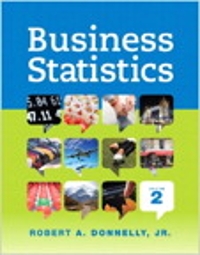Answered step by step
Verified Expert Solution
Question
1 Approved Answer
Question 1The airline industry defines an on-time flight as one that arrives within 15 minutes of its scheduled time. The following table shows the number
- Question 1The airline industry defines an on-time flight as one that arrives within 15 minutes of its scheduled time. The following table shows the number of on-time and late flights leaving Philadelphia and arriving in Orlando during a recent time period by airline:AirlineOn-TimeLateFrontier23968US Airways288130Southwest18063What is the probability that a randomly selected flight on this route was on time?What is the probability that a randomly selected flight was from Southwest and was on time?Do Airline and on-time performance seem to be dependent or independent? Explain your reasoning.What is the probability that a randomly selected flight was from Frontier or was on time?Given that the flight was late, what is the probability that it was from US Airways?Given that the flight was from Southwest, what is the probability that it was late?Construct a probability tree for these probabilities, branch first on Airline and then arrival timeliness. Handwritten trees are acceptable as long as they are readable.
- Question 2
- The following table shows the number of people, in thousands, in the United States with and without health insurance in 2011, according to the U.S. Census Bureau:Age GroupInsuredUninsuredUnder 18 years66,8356,90218 to 24 years22,4917,64925 to 34 years29,69011,52935 to 44 years31,5888,39945 to 64 years68,54413,38265 years and older40,817690 What percentage of the U.S. population in 2011 had health insurance and was between the ages of 18 to 24 years?What percentage of the U.S. population in 2011 had health insurance and was between the ages of 35 to 44 years?What percentage of the U.S. population in 2011 had health insurance, given they were 65 years or older?Do age group and health insurance appear to be independent or dependent events? What conclusions can be drawn with this information?Question 3Ann is the owner of Pizzas R Us, a small company that delivers pizza from two different locations. The Mayfair site handles 30% of the total orders while the Claymont location delivers the remaining orders. In its promotional materials, Pizzas R Us strives to deliver all orders within 45 minutes. Historically, the Claymont location has experienced 5% of its orders taking longer than 45 minutes to deliver. The Mayfair store has been late on 8% of its orders.Let’s define as “on-time” orders delivered within the 45 minutes, and as “late”, otherwise.Provide the appropriate probabilities for the following expressions:P(Claymont) =P(on-time|Claymont) =P(late|Claymont) =P(Mayfair) =P(on-time|Mayfair) =P(late|Mayfair) =2. Calculate the following joint probabilities:P(late AND Claymont) =P(late AND Mayfair) =3. Calculate the probability of “late” using the law of total probability.P(late) =4. Ann has just spoken to a customer whose order was delivered 1 hour after it was placed but did not remember which location the order originated. What is the probability that the late order came from the Mayfair store?
Step by Step Solution
There are 3 Steps involved in it
Step: 1

Get Instant Access to Expert-Tailored Solutions
See step-by-step solutions with expert insights and AI powered tools for academic success
Step: 2

Step: 3

Ace Your Homework with AI
Get the answers you need in no time with our AI-driven, step-by-step assistance
Get Started


